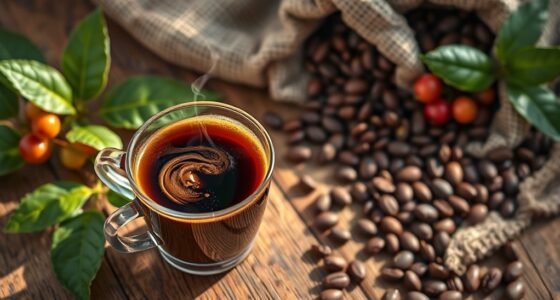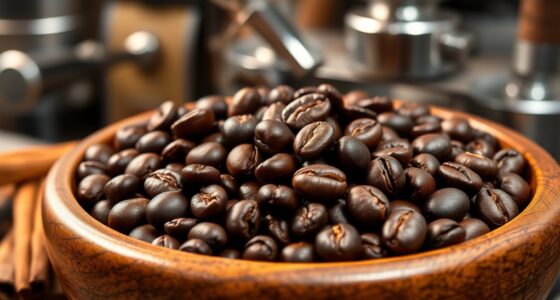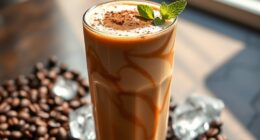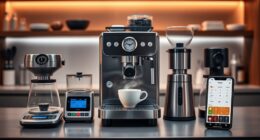Arabica coffee stands out from robusta in several ways. You’ll notice arabica has a smoother, sweeter flavor, while robusta tastes bolder and more bitter due to its higher caffeine content. Arabica beans thrive in cooler, high-altitude areas and require careful cultivation, making them costlier. Robusta beans, on the other hand, yield more and are cheaper. Plus, robusta boasts higher antioxidant levels, which might be beneficial for your health. There’s so much more to explore!
Key Takeaways
- Arabica beans have a smoother, sweeter flavor profile with chocolate and fruit notes, while robusta offers a bolder, earthier taste.
- Arabica contains 1.2% to 1.5% caffeine, whereas robusta has 2.2% to 2.7%, resulting in a more bitter flavor.
- Arabica requires higher altitudes and cooler temperatures for cultivation, making it more labor-intensive compared to robusta’s hardiness at lower elevations.
- Robusta cherries ripen simultaneously and are easier to harvest, while arabica cherries ripen unevenly, necessitating hand-picking.
- Arabica beans are generally more expensive due to their preferred flavor profile, despite robusta’s higher yield and lower production costs.
Flavor Profile Differences

When you plunge into the world of coffee, you’ll quickly notice the distinct flavor profile differences between arabica and robusta beans.
Arabica coffee beans are known for their smoother, sweeter flavor profile, often showcasing notes of chocolate, fruit, and floral undertones. In contrast, robusta coffee beans deliver a deeper, bolder taste with earthy and nutty characteristics.
While arabica’s higher sugar and lipid content contribute to its mildness, robusta’s caffeine content nearly doubles that of arabica, resulting in a more pronounced bitter taste. This bitterness can sometimes include off-putting notes like burnt rubber.
Although specialty robusta can compete with lower-quality arabica, the general preference leans toward arabica for its complex and balanced flavor profile.
Caffeine Content Comparison

While both arabica and robusta coffee beans offer unique flavors, the caffeine content is a significant factor that sets them apart.
Robusta contains approximately 2.2% to 2.7% caffeine, nearly double that of arabica, which ranges from 1.2% to 1.5%. This higher caffeine level in robusta contributes to its stronger and more bitter flavor profile, making it a popular choice for those seeking an intense caffeine kick.
Robusta boasts 2.2% to 2.7% caffeine, offering a stronger, more bitter flavor ideal for caffeine enthusiasts.
Additionally, robusta’s caffeine acts as a natural pest deterrent, enhancing its resilience in coffee production.
Because of its potency, you often brew robusta with half the amount compared to arabica, making it a cost-effective option for certain applications.
Ultimately, your preference will depend on whether you want a milder experience or a robust caffeine hit.
Growing Conditions and Cultivation

Growing conditions play an essential role in shaping the flavors and quality of coffee, with arabica and robusta thriving in distinct environments. You’ll find arabica beans flourishing at higher altitudes of 3,000 to 6,000 feet, while the robusta coffee plant prefers lower elevations between 200 to 800 meters.
- Arabica requires cooler temperatures and meticulous care, making cultivation more labor-intensive.
- Its cherries ripen unevenly, necessitating hand-picking, whereas robusta cherries ripen simultaneously for easier harvesting.
- The growing conditions impact the flavor profile, with arabica generally delivering a more refined and complex taste due to its slow growth process.
In contrast, robusta’s hardiness and adaptability make it a resilient choice for various environments.
Price and Market Factors

When you look at the coffee market, you’ll notice that Robusta beans are considerably cheaper than Arabica, thanks to their higher yields and lower production costs.
However, consumer demand often leans toward Arabica due to its rich flavor and quality.
This dynamic creates an interesting tension between cost-effectiveness and market preferences that shapes the coffee industry.
Cost of Production
Although producers often consider both quality and yield, the cost of production plays a crucial role in the coffee market. Robusta green beans are about half the price of Arabica, making them a more budget-friendly option. This cost-effectiveness stems from Robusta’s higher yield and natural resistance to pests.
Historically, roasters have blended Robusta into their coffee to cut costs, especially when Arabica market prices soar. However, despite these advantages, many consumers still prefer Arabica for its superior flavor and complexity.
- Robusta’s lower farming costs boost profitability.
- Arabica beans dominate over 60% of global production.
- Coffee blends featuring Robusta can save money for roasters.
Market Demand Trends
How do market demand trends shape coffee prices?
The demand for arabica coffee greatly influences its price, often commanding a premium due to its perceived quality and flavor complexity. While robusta beans are cheaper, priced at about half of arabica, consumer preferences lean heavily towards arabica, especially among specialty coffee roasters.
With around 75% of global coffee production being arabica, this trend reflects its dominance in the market. Fluctuations in coffee prices also stem from global supply and demand dynamics, where arabica is more vulnerable to price increases due to its specific growing conditions and higher production costs.
Ultimately, understanding these market trends helps you make informed choices when selecting your coffee.
Health Benefits and Antioxidants

While both Arabica and Robusta coffee offer health benefits, Robusta stands out for its higher antioxidant content, particularly chlorogenic acid.
This rich antioxidant profile may contribute to various health advantages, making Robusta a compelling choice.
Here are some potential health benefits of Robusta coffee:
- Higher chlorogenic acid levels: Robusta contains 7-10% compared to Arabica’s 5.5-8%.
- Anti-inflammatory properties: The antioxidants in Robusta may help reduce inflammation in the body.
- Improved metabolic health: Regular consumption could enhance your metabolic functions and reduce the risk of chronic diseases.
Usage and Blending Practices
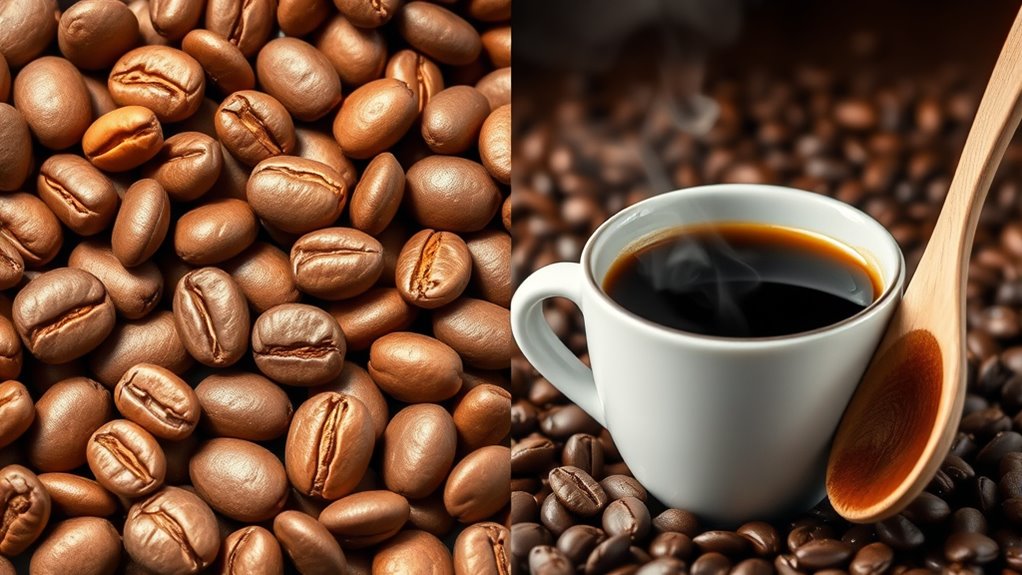
Coffee enthusiasts often seek the perfect blend to elevate their experience, and understanding the usage of Arabica and Robusta is key.
Arabica is favored for specialty blends due to its complex flavor profile, while robusta often serves as a cost-effective filler. High-end robusta isn’t widely available, making arabica the go-to for premium coffee.
In espresso blends, particularly Italian styles, robusta can enhance crema and deliver a stronger taste. Instant coffee makers frequently choose robusta for its lower production costs and higher yield compared to arabica.
Frequently Asked Questions
Which Is Better, Coffee Arabica or Robusta?
When it comes to choosing between coffee Arabica and robusta, it really depends on your taste preferences.
If you enjoy a smoother, sweeter flavor, you might lean towards Arabica. However, if you prefer a stronger, bolder coffee with higher caffeine, robusta could be your pick.
Consider your brewing methods too, as robusta is often used in espresso blends.
Ultimately, both have their merits; it’s all about what you enjoy most in your cup!
What Type of Coffee Bean Is Healthiest?
When it comes to health, robusta coffee beans might just be your best bet, like a knight in shining armor for your wellness.
With higher chlorogenic acid levels, they offer more antioxidants that can help reduce inflammation and improve blood sugar control.
Plus, the increased caffeine content gives you that extra boost.
If you’re looking for a bolder flavor and less sugar, robusta could be the healthiest choice for your daily brew.
Does Starbucks Use Arabica or Robusta?
You’ll find that Starbucks exclusively uses 100% arabica coffee beans in their offerings.
This choice highlights their commitment to quality and flavor complexity, ensuring you enjoy a smoother and sweeter coffee experience.
By avoiding robusta, which tends to be stronger and more bitter, Starbucks aligns its brand identity with the premium coffee market.
Why Don’t Stores Like Robusta Coffee?
Stores often shy away from Robusta coffee because it tends to have a stronger, more bitter flavor that many consumers don’t prefer.
You might notice that Arabica, with its smoother and sweeter taste, is more popular among shoppers, leading retailers to stock it more heavily.
Plus, Arabica beans account for a larger share of the market, so stores focus on what sells best, prioritizing quality and consumer satisfaction over cost.
Conclusion
In the rich tapestry of coffee, Arabica and Robusta each play their unique notes. Picture savoring a smooth, fragrant cup of Arabica, with its delicate hints of chocolate and fruit, while Robusta offers a bold, earthy punch that wakes up your senses. Whether you’re seeking the elegance of Arabica or the robust strength of Robusta, each sip tells a story. Understanding their differences not only enhances your coffee experience but also deepens your appreciation for this beloved beverage.

